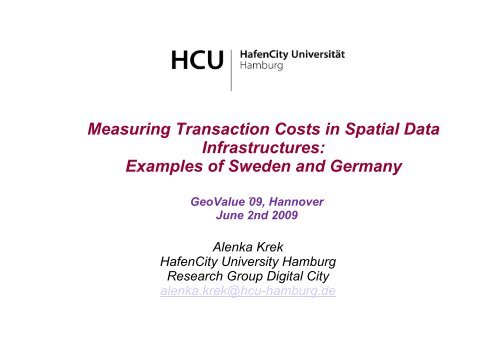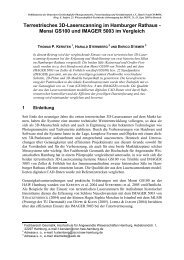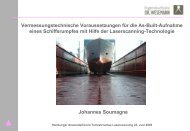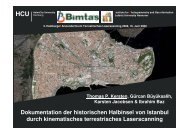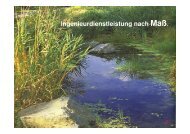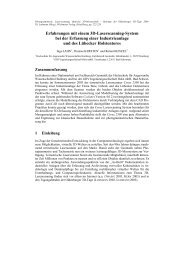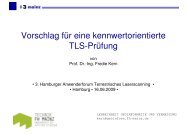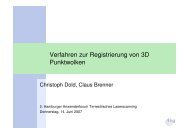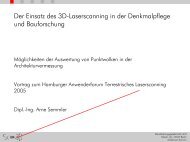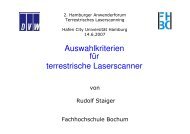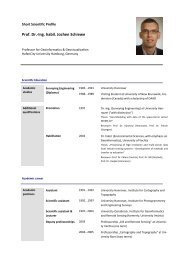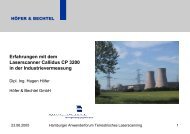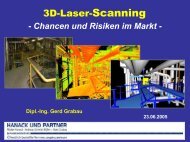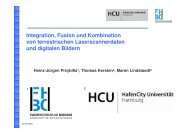Measuring Transaction Costs in Spatial Data Infrastructures ...
Measuring Transaction Costs in Spatial Data Infrastructures ...
Measuring Transaction Costs in Spatial Data Infrastructures ...
Create successful ePaper yourself
Turn your PDF publications into a flip-book with our unique Google optimized e-Paper software.
<strong>Measur<strong>in</strong>g</strong> <strong>Transaction</strong> <strong>Costs</strong> <strong>in</strong> <strong>Spatial</strong> <strong>Data</strong><br />
<strong>Infrastructures</strong>:<br />
Examples of Sweden and Germany<br />
Formatvorlage des GeoValue´09, Untertitelmasters Hannover<br />
durch Klicken<br />
bearbeiten<br />
June 2nd 2nd 2009<br />
Alenka Krek<br />
HafenCity University Hamburg<br />
Research Group Digital City<br />
alenka.krek@hcu-hamburg.de
Overview<br />
What are transaction costs?<br />
Can we measure them?<br />
Geo<strong>in</strong>formation transaction costs<br />
Experiments<br />
First results<br />
Conclusions and further work
Based on a True Story…<br />
Approximately 10 years ago….. <strong>in</strong> Vienna<br />
I just needed a simple street network dataset and thought it<br />
would be easy to acquire it;<br />
• I checked the website of the national mapp<strong>in</strong>g agency;<br />
• Found their phone number (but this was not the number<br />
of the responsible person);<br />
• I gave them a call, actually several calls, until I f<strong>in</strong>ally<br />
found the responsible person;<br />
• Visited them and spend 2,5 hours <strong>in</strong> their office, and<br />
• Got a copy of the data, which I couldn´t use….<br />
At the end: I digitised the needed streets/districts by myself.
What was I deal<strong>in</strong>g with?<br />
• <strong>Transaction</strong>: an exchange of spatial data is a<br />
transaction; it <strong>in</strong>volves parties e.g. the seller and the<br />
buyer who have to exchange <strong>in</strong>formation about the<br />
product.<br />
• A transaction can be costly: an <strong>in</strong>vestment <strong>in</strong> time and<br />
effort.<br />
• Special characteristics of spatial data: characteristics<br />
of an experiential good; the user/buyer is able to<br />
estimate the fitness of use of the dataset for an<br />
application after test<strong>in</strong>g it.
<strong>Transaction</strong> Cost Theory<br />
Neoclassical Economics: completely ignores transaction<br />
costs.<br />
Institutional Economics: Coase (1937) first <strong>in</strong>troduced the<br />
concept of transaction costs; article „The Nature of the Firm“.<br />
Accord<strong>in</strong>g to Cheung (1992) the transaction cost exists when<br />
there are transactions.<br />
Every exchange of the product entails costs that result from both<br />
parties attempt<strong>in</strong>g to determ<strong>in</strong>e the valued characteristics of the<br />
good (North 1997).
Quantify<strong>in</strong>g the <strong>Transaction</strong> <strong>Costs</strong><br />
Empirical studies try<strong>in</strong>g to quantify transaction costs<br />
measure the economic value of resources used <strong>in</strong> locat<strong>in</strong>g<br />
trad<strong>in</strong>g partners and execut<strong>in</strong>g transactions (Wang 2003).<br />
Another common measurement of transaction cost is the<br />
difference between the prices paid by the buyer and<br />
received by the seller.<br />
Some studies are concerned with the cost of government<br />
regulation imposed on market entry and transactions,<br />
which either reduces the market size or elim<strong>in</strong>ates the<br />
market.
Quantify<strong>in</strong>g <strong>Transaction</strong> <strong>Costs</strong><br />
Quantify<strong>in</strong>g the absolute level of TC<br />
Wallis and North (1986) estimated the TC <strong>in</strong> the U.S. “transaction<br />
sector”; <strong>in</strong>surance companies, wholesale, retail trade, and bank<strong>in</strong>g;<br />
45% of the national <strong>in</strong>come (GNP) was devoted to transact<strong>in</strong>g <strong>in</strong><br />
1970.<br />
Dollery and Leong (1998) studied TC <strong>in</strong> Australia; growth from<br />
32% <strong>in</strong> 1911 up to 60% of the total cost <strong>in</strong> 1991.<br />
Quantify<strong>in</strong>g the non-marketed TC<br />
Cost of wait<strong>in</strong>g, gett<strong>in</strong>g permits and licenses: Situation <strong>in</strong> Peru<br />
(North 1997); Gabre-Madh<strong>in</strong> (2001) quantified the cost of<br />
transaction faced by the traders <strong>in</strong> the Ethiopian gra<strong>in</strong> market: 19%<br />
of the total cost.<br />
Quantify<strong>in</strong>g the environmental TC
Sett<strong>in</strong>g up the Experiment<br />
Can we quantify the transaction cost of spatial data?<br />
• Two selected European SDIs: Sweden and Germany<br />
• Selected datasets<br />
• Def<strong>in</strong>ition of the geo<strong>in</strong>formation transaction costs<br />
• Def<strong>in</strong>ition of the measurement categories<br />
• First results
European SDIs:<br />
Sweden and Germany<br />
The situation <strong>in</strong> both countries is very different-two different<br />
organisational forms on the national level:<br />
• Sweden has a central <strong>in</strong>stitution (Lantmäteriet) provid<strong>in</strong>g basic<br />
geographic data<br />
• Germany offers a distributed network of state geo<strong>in</strong>formation<br />
and survey<strong>in</strong>g agencies: the services are offered by 15<br />
cadastral and survey<strong>in</strong>g authorities which act rather<br />
<strong>in</strong>dependantly
Selected <strong>Data</strong>sets<br />
Basic spatial data<br />
Real estate data<br />
Sweden: Malmö and Göteborg Germany: Hamburg<br />
Germany: Hamburg<br />
Sweden: GSD localities map<br />
Germany: real estate data
Geo<strong>in</strong>formation <strong>Transaction</strong> Cost<br />
<strong>Transaction</strong> costs <strong>in</strong>clude (North 1997):<br />
• the cost of measur<strong>in</strong>g what has been exchanged<br />
(measurement TC)<br />
• the cost of protect<strong>in</strong>g rights, plus polic<strong>in</strong>g and enforc<strong>in</strong>g<br />
agreements (enforc<strong>in</strong>g TC)<br />
The geo<strong>in</strong>formation transaction cost appears on the seller´s<br />
and buyer´s side:<br />
• demand geospatial transaction costs<br />
• supply geospatial transaction costs
Geo<strong>in</strong>formation Demand TC<br />
Geo<strong>in</strong>formation demand TC appear on the buyer´s side<br />
and <strong>in</strong>clude the costs related to the data acquisition.
Geo<strong>in</strong>formation Supply TC<br />
Geo<strong>in</strong>formation supply TC appear on the provider´s side<br />
and <strong>in</strong>clude the cost related to:<br />
• expla<strong>in</strong><strong>in</strong>g the complex rules about the use of data,<br />
• copyright issues,<br />
• non-transparent pric<strong>in</strong>g,<br />
• non-transparent licenc<strong>in</strong>g conditions,<br />
• rules of sale imposed to the buyers by national mapp<strong>in</strong>g<br />
agencies or other organisations, provid<strong>in</strong>g an access to<br />
spatial data <strong>in</strong>frastructures.
Def<strong>in</strong>ition of the TC <strong>in</strong> our Study<br />
We apply the def<strong>in</strong>ition as suggested by Wallis and North<br />
(1986) and Niehans (1987).<br />
Accord<strong>in</strong>g to them, the transaction costs are<br />
”all costs borne by the consumer that are not<br />
transferred to the seller of the good”.<br />
In our experiment we focus on the demand geo<strong>in</strong>formation<br />
transaction costs.
Measurement Categories (12)<br />
Category<br />
F<strong>in</strong>d<strong>in</strong>g the provid<strong>in</strong>g organization<br />
F<strong>in</strong>d<strong>in</strong>g the needed dataset<br />
F<strong>in</strong>d<strong>in</strong>g the actual seller<br />
Search<strong>in</strong>g for the contact <strong>in</strong>formation<br />
of the provider<br />
Description<br />
Search<strong>in</strong>g for the provid<strong>in</strong>g<br />
organization and its contact<br />
<strong>in</strong>formation<br />
Search<strong>in</strong>g for the <strong>in</strong>formation<br />
available on the Internet and<br />
contact<strong>in</strong>g the provider via phone<br />
and e-mail<br />
Time is spent <strong>in</strong> this category <strong>in</strong><br />
case several distributors sell the<br />
same or similar dataset<br />
Search<strong>in</strong>g via Internet, contact<strong>in</strong>g<br />
people that might have this<br />
<strong>in</strong>formation
Measurement Categories cont.<br />
Category<br />
Search<strong>in</strong>g for the contact person<br />
Description<br />
In case this <strong>in</strong>formation is not<br />
transparent, the buyer has to spend<br />
some time <strong>in</strong> search<strong>in</strong>g for the right<br />
responsible person<br />
Correspondence with the provider<br />
Contact<strong>in</strong>g the provider via phone<br />
Study<strong>in</strong>g the trade conditions<br />
Includes writ<strong>in</strong>g emails and read<strong>in</strong>g<br />
the provider’s responses<br />
Phon<strong>in</strong>g, wait<strong>in</strong>g for the responsible<br />
person, gett<strong>in</strong>g <strong>in</strong>formation about the<br />
availability of the responsible person<br />
Read<strong>in</strong>g licens<strong>in</strong>g conditions,<br />
copyright rights, terms of use
Measurement Categories cont.<br />
Category<br />
Study<strong>in</strong>g the pric<strong>in</strong>g policy<br />
Free sample data acquisition<br />
Test<strong>in</strong>g the Fitness of Use<br />
Description<br />
Search<strong>in</strong>g for <strong>in</strong>formation about the<br />
price, talk<strong>in</strong>g to the responsible<br />
person about the price, def<strong>in</strong><strong>in</strong>g the<br />
subject of the trade<br />
Download<strong>in</strong>g the free samples from<br />
the website, talk<strong>in</strong>g to the<br />
responsible person about send<strong>in</strong>g<br />
the free sample data<br />
Test<strong>in</strong>g the data quality, format and<br />
other characteristics with<strong>in</strong> the<br />
application<br />
Not <strong>in</strong>cluded <strong>in</strong> this study<br />
Actual data acquisition<br />
Not <strong>in</strong>cluded <strong>in</strong> this study
First Results<br />
…….based on our “ limited“ number of experiments (need<br />
to be additionally proved and researched)<br />
The organisational structure of a national SDI does matter:<br />
the TC for search<strong>in</strong>g the data provider is almost 0 <strong>in</strong><br />
Sweden due to the monopoly of the national provider<br />
The TC depend on the buyer´s pre-knowledge about the<br />
geo<strong>in</strong>formation market and possible dataset providers.
First Results<br />
cont.<br />
Geo<strong>in</strong>formation demand TC differ substantially between the<br />
basic spatial data and real estate data.<br />
The geo<strong>in</strong>formation demand TC is higher for the specific dataset,<br />
which is not <strong>in</strong> the standard offer of the data provider; real<br />
estate data for example.<br />
The highest geo<strong>in</strong>formation demand TC was found <strong>in</strong> the<br />
categories of :<br />
• search<strong>in</strong>g for the provid<strong>in</strong>g organisation,<br />
• correspondence with the provider, and<br />
• f<strong>in</strong>d<strong>in</strong>g the right seller.
Conclusions<br />
We demonstrated our research methodology for quantify<strong>in</strong>g<br />
the geo<strong>in</strong>formation demand transaction costs.<br />
The experiments <strong>in</strong> Sweden and Germany resulted <strong>in</strong> our<br />
first estimations of the geo<strong>in</strong>formation demand TC and<br />
helped us to improve the methodology.<br />
Further research questions:<br />
• How to design the SDIs <strong>in</strong> order to reduce transaction<br />
costs for the buyer?<br />
• How to measure transaction costs of the provider and<br />
how to reduce it?
Further Work<br />
Further research agenda <strong>in</strong>cludes:<br />
• <strong>in</strong>creased test<strong>in</strong>g samples; <strong>in</strong>clud<strong>in</strong>g additional potential<br />
buyers<br />
• differentiate between a novice and a knowledgable<br />
potential buyer,<br />
• <strong>in</strong>clud<strong>in</strong>g different datasets,<br />
• study the dependence of the geo<strong>in</strong>formation demand TC<br />
and the organisation of a SDI<br />
• study the dependence of the geo<strong>in</strong>formation demand TC<br />
and technical caracteristics of a web service.
Thank you for your <strong>in</strong>terest!<br />
Questions?<br />
Alenka Krek<br />
HafenCity University Hamburg<br />
Research Group Digital City<br />
alenka.krek@hcu-hamburg.de<br />
http://www.hcu-hamburg.de


